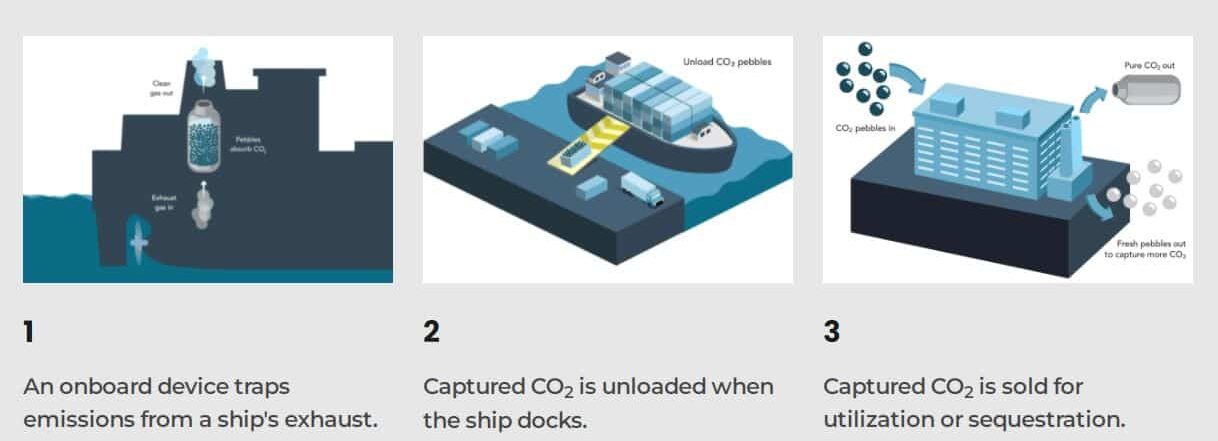The shipping industry has been looking for ways to slash emissions and a tech startup, Seabound, is gearing up to help decarbonize the big ships with its novel carbon capture technology.
Ships emit ~1 billion tonnes of greenhouse gas each year, which is more than airplanes. The new International Maritime Organization (IMO) regulations require the shipping industry to cut emissions by 40% by 2023.
London-based Seabound is prototyping its technology to capture CO2 emissions from ships. Its unique approach to carbon capture can trap up to 95% of CO2 emissions per ship.
Seabound’s Carbon Capture for Ships
Though carbon capture hasn’t yet caught on for ships, Seabound is one of the companies out to prove the tech is scalable. This climate tech startup was founded just last year.
The firm installs its carbon capture equipment on both existing and new ships to capture up to 95% of their CO2 emissions at point of source. It seeks to help the largest cargo ships meet upcoming IMO regulations that will kick off next year.
Other firms that develop carbon capture technology for ships are using the most established solvent-based approach. This has been used commonly in factories.
But such a tested method needs more space and energy when onboard the ships. That’s because the process of capturing the CO2 takes place on the shipping vessel.
In contrast, Seabound aims to capture and process the CO2 on land.
Here’s how the carbon capture process of Seabound works:

The tech firm’s reactor connects to a ship’s smokestacks to capture carbon right from the source of emissions.
The onboard device filled with porous, calcium oxide pebbles traps CO2 from a ship’s exhaust. Then the captured CO2 gets unloaded when the ship docks.
As per the company’s co-founder and CEO, Alisha Fredriksson:
“The pebbles bind to carbon dioxide to form calcium carbonate, which is essentially limestone… The reactor stores it on board temporarily until the ship gets back into port, where it’s offloaded and post processed. And then we sell that captured CO2 for use into fuels or chemicals. Or for sequestration.”
Fredriksson further added that its system is a second generation form of CO2 capture technology. The firm is working on a novel compact version of a carbon capture reactor. And they have a patent pending for that.
Seabound also says it has signed six letters of intent (LOIs) with major ship owners. It aims to trial its carbon capture tech aboard ships beginning next year.
To get there, the company has secured $4.4 million in a seed round led by Chris Sacca’s Lowercarbon Capital. Other investors that chipped in on the deal include Eastern Pacific Shipping, Emles Venture Partners, Hawktail, Rebel Fund and Soma Capital.
Decarbonizing the Shipping Industry
In general, the shipping industry is just starting to figure out how it’s going to reduce emissions.
It’s very dependent on fossil fuels and emitted about 1.2 gigatons of CO2e in 2020. That’s equal to about 3% of global GHG emissions.
While there are a lot of potential solutions that others are working on, such as the alternative fuels like hydrogen and biofuels, they are still about 10 to 20 years away from maturity. And they’re only suitable for brand new ships.
- But what the industry needs is a solution that can reduce emissions today and something that works for all of the existing ships that will still sail for 30 years.
So, we need technology that can be an add on or a retrofit onto the existing ships. That’s better than having to completely replace the whole ship’s fuel supply or the whole propulsion system.
The industry has to decarbonize because it needs to comply with regulation. Plus, customers are also now asking for it.
But the shipping is so hard to abate is because of the energy requirements to transport large volumes of goods over long distances.
In a sense, if we look at the largest ships in the world traveling long distances, electrifying them is not easy. Electrification will work only for smaller ships traveling shorter distances or more coastal routes.
That’s where the “lime-based” carbon capture approach of Seabound comes in.
Capturing the CO2 on ships sailing today will address the urgent need to reduce emissions.
And in the long run, Seabound’s carbon capture tech can work with alternative fuels. This results in a carbon negative system while still allowing the large ships to use the existing types of propulsion.
In such a way, the startup’s CO2 capture enables cargo ship owners to have lower expenses than existing approaches. No need to invest in new vessels and they can even earn income from the revenue of selling captured CO2.

